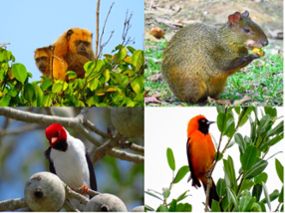Save the umbrella for a rainy day: An alternative way forward for conservation

Popular conservation campaigns featuring mammals with big eyes and fuzzy features implies that to besaved, an animal best be cute.
Yet species less well known and not as visually pleasing have essential roles within our ecosystems and are sometimes left out of critical assessments of our world’s biodiversity.
This is due to the high uncertainty about their conservation status and potential threats. A 2015 study in Biological Conservation showed that the omission of these species can lead to an underestimate of biodiversity and misappropriation of conservation programs to certain areas. Several faculty members in MSU's Ecology, Evolution, and Behavior (EEB) program, including integrative biologist Phoebe Zarnetske, indicate that a focus on species providing ecosystem services may be the way forward to increase inclusivity for these important and lesser-known creatures.
“We need to focus on maintaining healthy ecosystem function,” said Zarnetske, associate professor in the MSU College of Natural Science (NatSci) Department of Integrative Biology. “Without healthy ecosystems, the many services that humans and nature rely on will be in jeopardy, including clean water, pollination, nutrient cycling, healthy fisheries, and many others. Unfortunately, these services are already in jeopardy in many regions of the world.”
Conservation campaigns meant to raise funds and public awareness, such as the World Wildlife Fund campaign for pandas, are lucrative and can help save habitat for the charismatic flagship species, with the intention of that focal species serving as an umbrella of protection for other species sharing the same habitat.
However, the Biological Conservation story co-authored by MSU’s Jianguo "Jack" Liu and then Ph.D. student Thomas Conner, showed that the umbrella approach for panda conservation did not adequately protect all species with overlapping ranges after taking habitat loss and degradation into consideration. This is a likely reality for many species sheltered under the “umbrella” of a flagship species’ protection and can lead to issues with the long-term success of this approach.
Additionally, this focus on charismatic species can lead the public to believe that these critters are the only kinds of animals worth saving. One of the downfalls of the flagship umbrella approach is that species are chosen based solely upon their appeal to a wide audience. However, many species play integral roles in ecosystems, provide humans with crucial services, and need to be prioritized for conservation. Think bees for pollination, bats and lady beetles for pest control, birds and bats for seed dispersal.
Zarnetske suggests an alternative approach to choosing which species should receive priority for conservation efforts – one based not on their looks, but on their roles within an ecosystem.
“The main advantage to using species’ functional roles to prioritize conservation efforts is that species’ functions align more directly with ecosystem functions and services—such as nutrient cycling and pollination—which are necessary for humans and nature alike,” said Zarnetske, whose research focuses on community ecology and the impact of climate change across scales.

“These functions and services affect many species, not just a particular focal species, and so focusing on a suite of species and their particular traits involved in providing the functions and services can more effectively conserve a much wider array of species.” For example, focusing on conserving animals which spread seeds, and thus preserve long-term forest survival.
While this alternative approach has the potential to protect a wider range of species, it is not without complication. As Zarnetske points out, “A disadvantage to focusing on species’ functional roles to prioritize conservation is that we lack this basic information for some of the more rare or lesser-known species”.
Many of the world’s species suffer from this lack of in-depth knowledge about their geographical range limits, population dynamics, habits, and threats needed to truly understand their conservation status, which has slowed our progress in fully understanding the important roles that these less charismatic organisms play in our ecosystems.
To learn more about biodiversity research efforts and activities in NatSci and EEB, visit "Connections".
This article was excerpted from the original story written by Beth E. Gerstner, a Ph.D. student in fisheries and wildlife studying with Phoebe Zarnetske, and a Digital Fellow in the Ecology, Evolution, and Behavior Program. To read the complete story, visit: https://eeb.msu.edu/initiatives/digital-fellows/save-the-umbrella-for-a-rainy-day-an-alternative-way-forward-for-conservation/.
Banner image: Phoebe Zarnetske, associate professor in the Department of Integrative Biology and her Spatial and Community Ecology lab, or SpaCE, are pioneers in collecting and organizing massive amounts of ecological data to understand how species interactions and geodiversity are interacting with climate change to drive precipitous biodiversity shifts. Credit: Sharks: Albert kok, Wikimedia; Alaskan North Slope: Jay Zarnetske; and Ecuador tropical forest and hummingbird, caribou, Oregon rocky intertidal and tidepool, Caribbean Sea: Phoebe Zarnetske